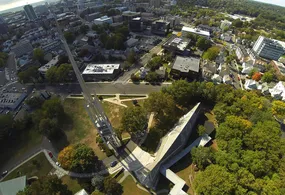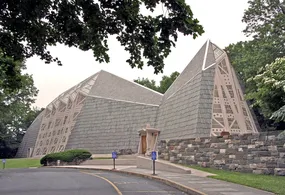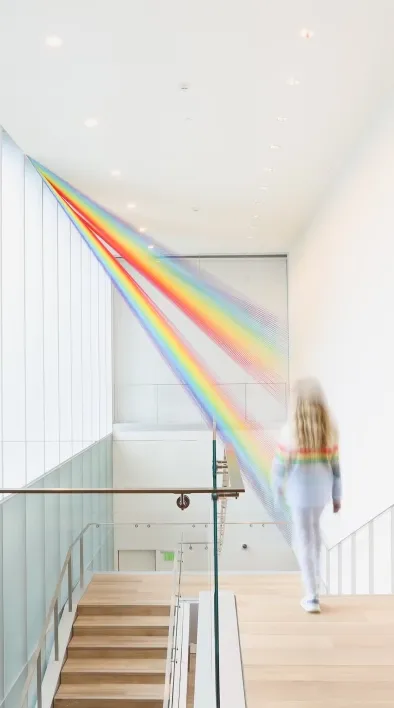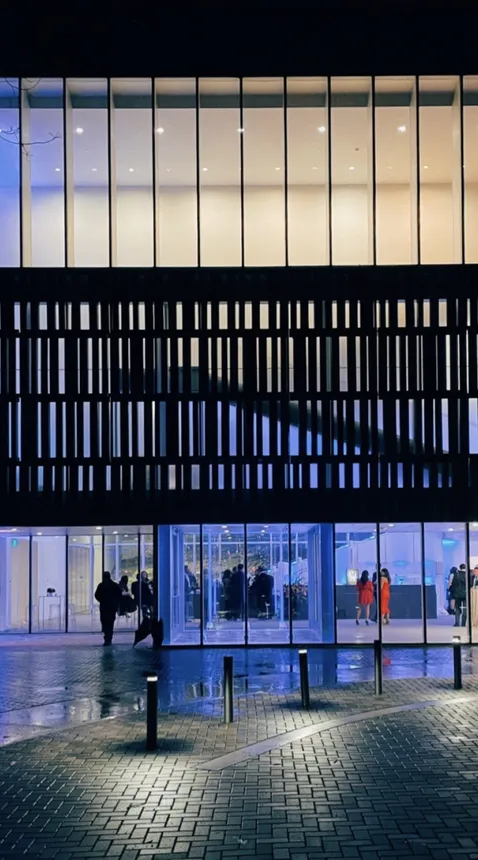The First Presbyterian Church - Sanctuary Interior, photo by Robert Gregson 2020 @gregson_robert
Location: 1101 Bedford Street, Stamford, CT 06905
The main parking lot is off the circular drive from Bedford Street.
Touring information is as follows:
- Monday – Friday - 9:00 am – 4:30 pm
- Sunday Service 10:00 am
Docent Led Tours Available
- Please call the office at 203-324-9522 or tours@highlandgreenfoundation.org
- Please give 5 day notice
Description:
Designed by Wallace K. Harrison (1895-1981), and dedicated in 1958, the First Presbyterian Church in Stamford, CT, known locally as the Fish Church, is a modernist architectural gem. Harrison, one of the preeminent architects of his time, acting as a lead architect for the Lincoln Center for the Performing Arts, Rockefeller Center, and the United Nations. While Harrison’s commercial buildings are straightforward in conception and their occupant first design, it was the beauty and the magic of his buildings’ proportions that drew the congregants of First Presbyterian to Harrison.
In approaching the design of the First Presbyterian Church, Harrison sought inspiration from classic Gothic cathedrals, like Notre Dame and Chartres. Simultaneously, Harrison looked to modern construction methods and materials to produce a result which he described as “what it would be like to live inside of a giant sapphire.” Using dalle de verre or ‘glass slab’ instead of traditional stained glass for the church’s windows, and pre-formed folded concrete for the walls, Harrison created a space that feels simultaneously grounded and impossibly light.
Each aspect of First Presbyterian's design was a conscious choice, from the shape of the building similar to an elongated megaphone which spreads the sound to the rear of the building to the use of wood from Canterbury Cathedral to create the 32-foot cross that hangs in the chancel, an area around the altar. (The association of the Church’s shape with a fish came later.) In keeping with this intentionality is Harrison’s freestanding Carillon Tower. Made of poured in-place concrete, the Tower is two stories tall and home to 56 carillon bells. Visible in Stamford’s skyline, the bells can be heard from over a mile away, if traffic on I-95 is quiet enough.
In January 2021, the United States government designated First Presbyterian Church as a National Historic Landmark, in recognition of its historic significance.
La Primera Iglesia Presbiteriana y la Torre de Carillón
La Primera Iglesia Presbiteriana - Interior del Santuario, fotografía de Robert Gregson 2020 @gregson_robert
Ubicación: 1101 Bedford Street, Stamford, CT 06905
El estacionamiento principal se encuentra junto a la entrada circular desde Bedford Street.
Información turística:
- De lunes a viernes de 9:00 a. m. a 4:30 p. m.
- Servicio dominical a las 10:00 a. m.
Visitas guiadas por docentes disponibles
- Llame a la oficina al 203-324-9522 o visite tours@highlandgreenfoundation.org
- Avise con 5 días de antelación
Descripción:
Diseñada por Wallace K. Harrison (1895-1981) e inaugurada en 1958, la Primera Iglesia Presbiteriana en Stamford, Connecticut, conocida localmente como la Iglesia del Pescado, es una joya de la arquitectura modernista. Harrison, uno de los arquitectos más destacados de su tiempo, ejerció como arquitecto principal del Lincoln Center for the Performing Arts, el Rockefeller Center y las Naciones Unidas. Mientras que los edificios comerciales de Harrison son directos en su concepción y están diseñados para priorizar a los residentes, los feligreses de la Primera Iglesia Presbiteriana eligieron al artista por la belleza y la magia de las proporciones de sus edificios.
Al abordar el diseño de la Primera Iglesia Presbiteriana, Harrison se inspiró en las catedrales góticas clásicas, como Notre Dame y Chartres. Al mismo tiempo, Harrison recurrió a métodos y materiales de construcción modernos para producir un resultado que, en sus palabras, “fuera como vivir dentro de un zafiro gigante”. Mediante el uso de dalle de verre o “placas de vidrio” en lugar de los vitrales tradicionales para las ventanas de la iglesia, y concreto plegado preformado para las paredes, Harrison creó un espacio que es sólido y, al mismo tiempo, sorprendentemente ligero.
Cada aspecto del diseño de la Primera Iglesia Presbiteriana fue una elección consciente, desde la forma del edificio —similar a un megáfono alargado que difunde el sonido a la parte trasera del edificio— hasta el uso de madera de la Catedral de Canterbury para crear la cruz de 32 pies que cuelga en el presbiterio, una zona alrededor del altar. (La asociación de la forma de la Iglesia con un pez se hizo más adelante). En consonancia con esta intencionalidad se encuentra la Torre de Carillón de Harrison, una edificación independiente. Fabricada con hormigón vertido en el lugar, la torre tiene dos pisos de altura y alberga 56 campanas de carillón. Las campanas pueden verse en el horizonte de Stamford y se escuchan a más de una milla de distancia si no hay mucho tráfico en la I-95.
En enero de 2021, el gobierno de los Estados Unidos designó a la Primera Iglesia Presbiteriana como Monumento Histórico Nacional en reconocimiento a su importancia histórica.







